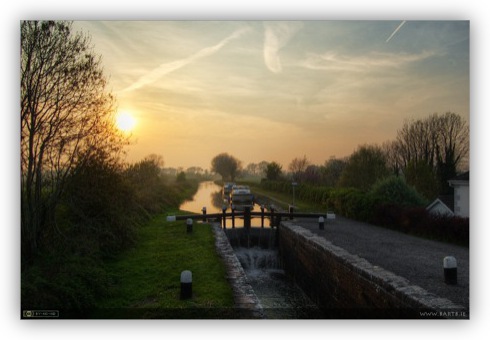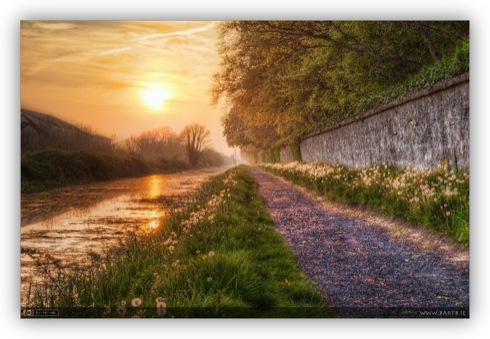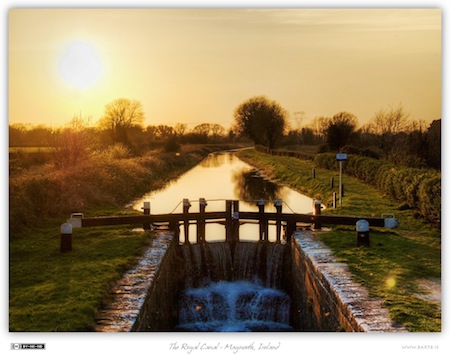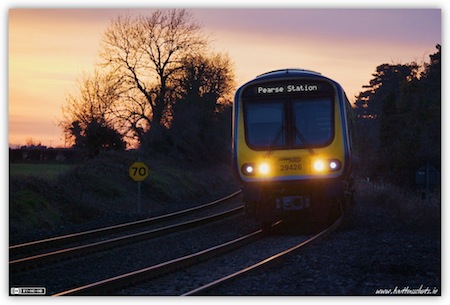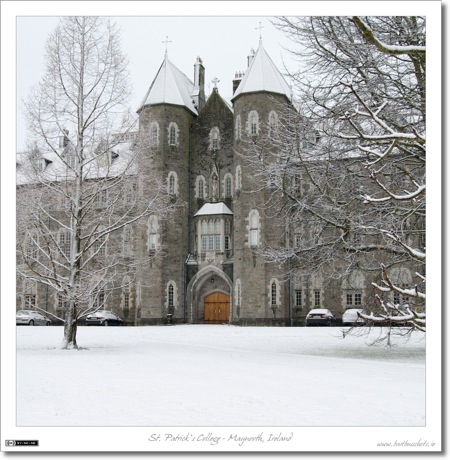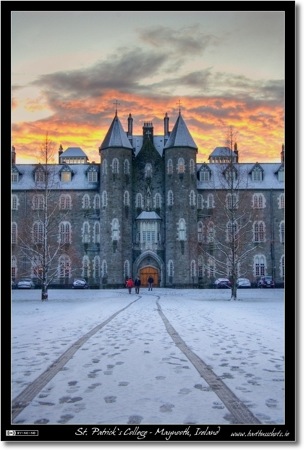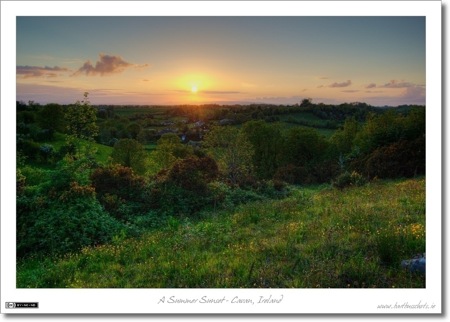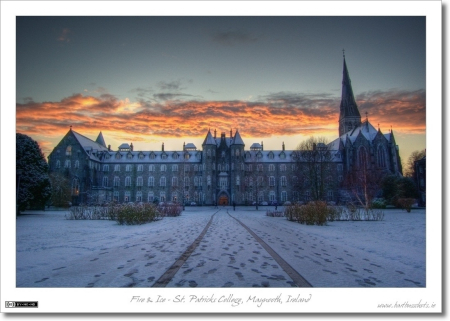May
23
Photo of the Week 170 & 171 – Royal Canal HDR
Filed Under Photography on May 23, 2011 | 6 Comments
I spent so much energy writing my big HDR article last weekend that I didn’t get around to posting my Photo of the Week, so another double post this week to catch up. I thought I’d stick to the theme of HDR, and also pick two shots of the same subject, the Royal Canal. This canal is very special to me as it’s where I get most of my exercise, and the vast majority of my nature photos, as well as many of my railway shots too! I do a lot of pseudo-HDR shots where I tonemap single RAW images, but I hardly ever take the time to create ‘true’ HDRs by combining multiple separate exposures. Last month, for the first time in ages, I spent some time shooting some ‘real’ HDRs, and these two are my favourites.
The first is a very low-key naturalistic HDR showing two boats moored above the 14th lock on the Royal Canal at Jackson’s Bridge near Maynooth as a spring sun sets. This HDR was generated from four brackets.
- Camera: Nikon D40
- Lens: Nikon DX AFS 18-55mm (D40 kit lens)
- Exposure:
- Bracket 1: 1/100
- Bracket 2: 1/200
- Bracket 3: 1/400
- Bracket 4: 1/800
- Focal Length: 22mm
- Focal Ratio: f/11
- ISO: 400
- Camera Mode: Full Manual
- Processing: created by combining four RAW images into a single tonemap in Photomatix Pro, then running that tonemap through Topaz Adjust before importing into Aperture 3 for a few final tweaks
The second shot I’ve chosen was processed to capture the feeling and atmosphere of the scene, rather than to capture it exactly as it looked to the eye. This is a much more extravagant HDR, and perhaps a little hyper-real. It was the absolute sea of Dandelion seed heads and the reflection of the setting sun in the water that caught my eye and inspired me to stop and set up my the tripod for a full HDR. This beautiful stretch of the canal is located between Maynooth village and Jackson’s Bridge, and the wall running along the canal here is the boundary wall for St. Patrick’s College (SPCM). This shot was also generated from 4 brackets.
- Camera: Nikon D40
- Lens: Nikon DX AFS 18-55mm (D40 kit lens)
- Exposure:
- Bracket 1: 1/50
- Bracket 2: 1/100
- Bracket 3: 1/200
- Bracket 4: 1/400
- Focal Length: 42mm
- Focal Ratio: f/8
- ISO: 200
- Camera Mode: Full Manual
- Processing: created by combining four RAW images into a single tonemap in Photomatix Pro, then running that tonemap through Topaz Adjust before importing into Aperture 3 for a few final tweaks
May
4
Photo of the Week 114 & 115 – Sunsets
Filed Under Photography on May 4, 2010 | 2 Comments
Since I was away in Belgium the previous weekend, this is yet another double post to get caught up. Again, double post means a single theme for both images. Inspired by all the talk of ash clouds leading to nice sunsets, I’ve picked two of my recent favorite sunset/dusk shots for this post.
The first shot was indeed taken while the recent volcanic ash cloud was making a nuisance of itself over Ireland. It was taken from Jackson’s Bridge (located between Maynooth and Kilcock) looking west along the Royal Canal. In the foreground you can see the 14th lock. 13 Locks to the east of here the Royal Canal starts at the old docks in Dublin, and 32 locks to the west it enters the river Shannon.
- Camera: Nikon D40
- Lens: Nikon DX AFS 18-55mm (D40 kit lens)
- Exposure: 1/500 sec
- Focal Length: 38mm
- Focal Ratio: f/8
- ISO: 200
- Camera Mode: Full Manual
- Processing: This shot was generated by tonemapping the original RAW file with Photomatix Pro, and then tweaking the resulting image with Topaz Adjust 4
The second shot I’ve chosen is a little older, and pre-dates all the ash-cloud excitement. Perhaps unsurprisingly, it’s of a train, in this case an evening Commuter service from Maynooth to Dublin looming into shot out of a spectacular sunset.
- Camera: Nikon D40
- Lens: Nikon DX AFS 55-200mm
- Exposure: 1/400 sec
- Focal Length: 120mm
- Focal Ratio: f/5
- ISO: 800
- Camera Mode: Full Manual
- Processing: This shot was generated by tonemapping the original RAW file (first converted to 16bit TIFF) with Topaz Adjust 4, and then tweaking the resulting image with Aperture’s Dodge & Burn plugin
Dec
27
Photo of the Week 96 & 97 – The Beauty of Winter
Filed Under Photography on December 27, 2009 | 1 Comment
With the silly-season in full swing it’s probably no big surprise that I find myself a week behind again, so another double post this week. This time I decided to choose a seasonal topic – winter scenes. As it happens both these shots were taken on the same day, the 3rd of February this year. It started to snow in the late afternoon, stopped in time to get some lovely day-time shots, and then the sky cleared to give a dramatic sunset over the snow-covered landscape. A photographer’s dream, and this afternoon has already supplied two pervious Photos of the Week (50 “Braving the Snow” & 52 “Fire & Ice”).
- Camera: Nikon D40
- Lens: Nikon DX AFS 18-55mm (D40 kit lens)
- Exposure: 1/50 sec
- Focal Length: 26mm
- Focal Ratio: f/8
- ISO: 800
- Camera Mode: Aperture Priority
- Camera: Nikon D40
- Lens: Nikon DX AFS 18-55mm (D40 kit lens)
- Exposure: 1/100 sec
- Focal Length: 34mm
- Focal Ratio: f/8
- ISO: 800
- Camera Mode: Aperture Priority
- Exposure Bias: -1.0ev
- Processing: Single RAW image first tonemapped with Photomatix Pro, then tweaked with the Dodge & Burn plugin in Apple’s Aperture
Jul
4
Photo of the Week 71 & 72 – A Cavan Sunset
Filed Under Photography on July 4, 2009 | 4 Comments
I’ve found myself one week behind yet again, so, for what seems like the millionth time, I’m doing a double-post this weekend. As always with these multiple posts, I’m choosing two related photos, in this case, VERY related photos, they were both taken within a few minutes of each other of the very same subject! The reason I’ve chosen to do these together is because they show two approaches to the same situation.
When you shoot a sunset the dynamic range is exceptionally high. You are shooting into the sun, and at the same time, the ground is getting dark, so, you have a very bright subject, with very dark surroundings. The range between the brightest and darkest range of the scene is just too big for a camera to take in. This leaves you with a choice between two approaches, both of which can make for fantastic photos.
As a complete geek, my first reaction is to throw technology at the problem. Although the technology I threw at the problem is quite modern (HDR photography), the idea is not new. In the past people would use graduated filters to solve the same problem. With a graduated filter the top of the filter blocks quite a lot of light, the bottom, none. You can get filters that have very abrupt graduations where half the filter is dark, the other half completely transparent with a very short transition between the two regions, or you can have filters that go smoothly from dark to light over the entire length of the filter. Different situations will call for different filters, but the aim is the same, get both the bright bits and the dark bits properly exposed despite the large difference in brightness between them (i.e. the large dynamic range). I don’t own any filters, so that’s not what I did. Instead, I used a technique called Tonemapping on a RAW file. The result is that you can see detail in both the bright sky and the dark landscape in this shot, which is the first of my two photos for this week:
- Camera: Nikon D40
- Lens: Nikon DX AFS 18-55mm (D40 kit lens)
- Exposure: 1/320 sec
- Focal Length: 18mm
- Focal Ratio: f/8
- ISO: 200
- Camera Mode: Aperture Priority
- Exposure Bias: -1.0EV
- Processing: Generated by tonemapping a single RAW file in Photomatix Pro.
So that’s an example of taking the first option for dealing with a high dynamic range, use technology to get around it. So what’s the second option? Don’t fight it, accept it, and use it! If you can’t get everything exposed properly, don’t even try, instead, intentionally only expose for one element. With a sunset that one element is the sky, and then you intentionally throw the rest into silhouette. You intentionally take away all exposure in your foreground! This can result in a lot of black space in your image, so you often have to crop pretty hard to make this work well. An example of this is the second image I’ve chosen for this week:
- Camera: Nikon D40
- Lens: Nikon DX AFS 18-55mm (D40 kit lens)
- Exposure: 1/640 sec
- Focal Length: 55mm
- Focal Ratio: f/8
- ISO: 200
- Camera Mode: Aperture Priority
- Exposure Bias: -2.0EV
Feb
18
Photo of the Week 52 – Fire & Ice
Filed Under Photography on February 18, 2009 | 5 Comments
It’s hard to believe I’ve been doing these weekly posts for a year now! I’m so glad this idea worked out, it’s really helped my keep blogging and keep taking photos.
This shot was taken in St. Joseph’s Square on the St. Patrick’s College Campus (AKA NUI Maynooth South Campus) in Maynooth, Ireland. It was taken later the same day as the photo I used for Photo of the Week 50. After it stopped snowing we got a really dramatic sunset over the freshly whitened landscape. It was an amazing sight to behold. The shot was taken from the middle of St. Joseph’s Square looking west towards St. Patrick’s House, and shows two of the campus’s best known landmarks, the President’s Arch (the door between the two towers), and the Gunne Chapel (AKA the College Chapel).
- Camera: Nikon D40
- Lens: Nikon DX AFS 18-55mm (D40 kit lens)
- Exposure: 1/160 sec
- Focal Length: 18mm
- Focal Ratio: F8
- ISO: 800
- Camera Mode: Aperture Priority
- Processing: This image was generated from a single RAW file converted to a pseudo-HDR image and then tone-mapped with Photomatix Pro. You can see the un-tone-mapped version here.







